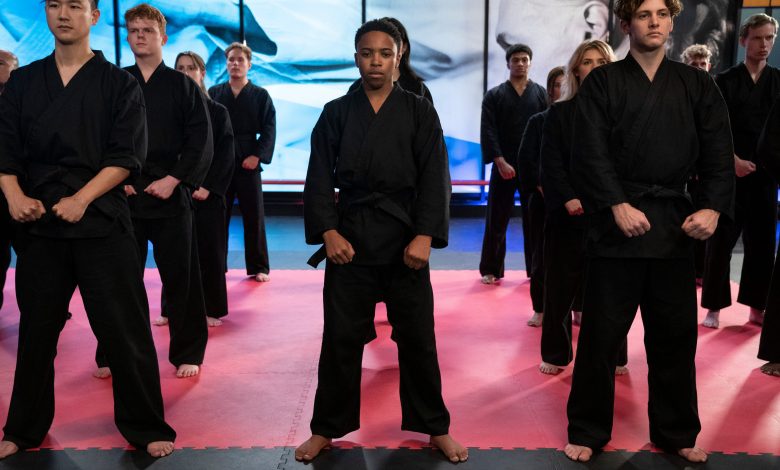Cobra Kai Season 5 Punches Harder than Ever

Charlie von Peterffy ‘24 / Entertainment Monthly Staff Writer
Cobra Kai, the long-running sequel series to 1984’s The Karate Kid, has uprooted expectations both for franchise fans and legacy sequels in general. Five years ago, no one could have expected another Karate Kid reboot to have succeeded; Jaden Smith and Jackie Chan had already tried, buckling under the weight of the franchise’s legacy. Fortunately, Cobra Kai has done precisely the opposite. With a great cast of ensemble characters with enticing arcs, lots of explosive and emotionally impactful action, and a list of resonating themes, this show has consistently proven that legacy sequels can be great––and sometimes even better than the original.
Cobra Kai is a series revolving around karate. Senseis and karate students fight with or against one another for competitive and ethical reasons. In the fifth season of Cobra Kai, Daniel LaRusso (Ralph Macchio)—the original Karate Kid star—his first tournament opponent-turned-sensei Johnny Lawrence (William Zabka), and all other parties involved come together to take down another familiar foe, Terry Silver (Thomas Ian Griffith). Everyone works to uncover the truth about Silver and his plans on all opposing sides. As the season progresses, it is revealed that he plans to turn Cobra Kai into a global karate empire. Because the dojo revolves around striking first and showing no mercy, LaRusso and Lawrence worry that it will make more bullies than warriors, and therefore, must stop Silver before he corrupts more students worldwide.
The story is excellent. Filled with excitement, a slow build in tension, and unpredictable twists and turns, it invites audiences into the show’s world while keeping them rooted. Like its predecessors, this season ups the ante to the highest degree. Knowing that a dojo as bashful and dishonorable as Cobra Kai could become global helps, of course. However, how this development affects the characters most robustly drives the story. Unlike in past seasons, most of the prominent characters are beaten to their core, left vulnerable and raw. Seeing them in this state drives the story, as they make the least effective––but most human––decisions yet. This innately makes the story more enticing, as the characters feel more grounded in reality than in the past. Everyone makes rash decisions, so seeing that reflected on screen is soothing.
The cast is super strong, enhancing these characters’ emotional ranges in mesmerizing ways. Their ability to bounce between subtle reactions and sweeping emotional beats makes every character feel natural. Griffiths’s work deserves a lot of praise. Through his ability to be intimidating yet charming, he makes the most charismatically manic character seen in the series yet. Because of him, Silver is a complex character with much more integrity than his predecessor, John Kreese (Martin Kove), making for some genuinely enraging conflicts between him and the rest of the characters. He is easily the most substantial part of the season, proving himself to be a more-than-formidable foe for the original karate kid and the rest of his team.
The visuals are also superb. With sumptuous cinematography, stellar choreography, and great set design pieces, Cobra Kai is the flashiest and most eye-popping it has been since it started. It is a bit experimental in form-fitting techniques, particularly in the first few episodes. It uses different lighting styles, shooting angles, and dialogue coverage techniques to create a new emotional weight that the show has not had before. These tests make the series embellishing and unique in its approach to the craft.
The only issues with the show stem from its tendency to underdevelop new plot threads and characters. New characters are introduced throughout the season, whether entirely original or pulled from the old movies. Unfortunately, none of them experience change or growth. For example, although the reintroduction of Mike Barnes (Sean Kanan)—LaRusso’s archenemy from The Karate Kid Part III—is welcome and rejuvenating thanks to Kanan’s simple but sweet performance, the character has no real value in the show. He briefly appears in two different episodes, restricting potential growth because he lacks screen time. In cutting him out, Barnes feels more like a cameo appearance than a character from LaRusso’s past. Similarly, the brand-new characters in this season exist merely as new obstacles for the main characters to conquer. They have no depth, no attachment to the rest of the show, and absolutely no emotional connections with the audience. As a result, all these characters feel wasted; afterthoughts of the script’s final drafts.
Overall, Cobra Kai is back and better than ever. Swinging in all directions with incredible ease, it masterfully continues the tale of karate’s generational importance. With consistently outstanding performances, kick-butt action, and emotional brevity, the series shows no signs of slowing down––or any reason it should.